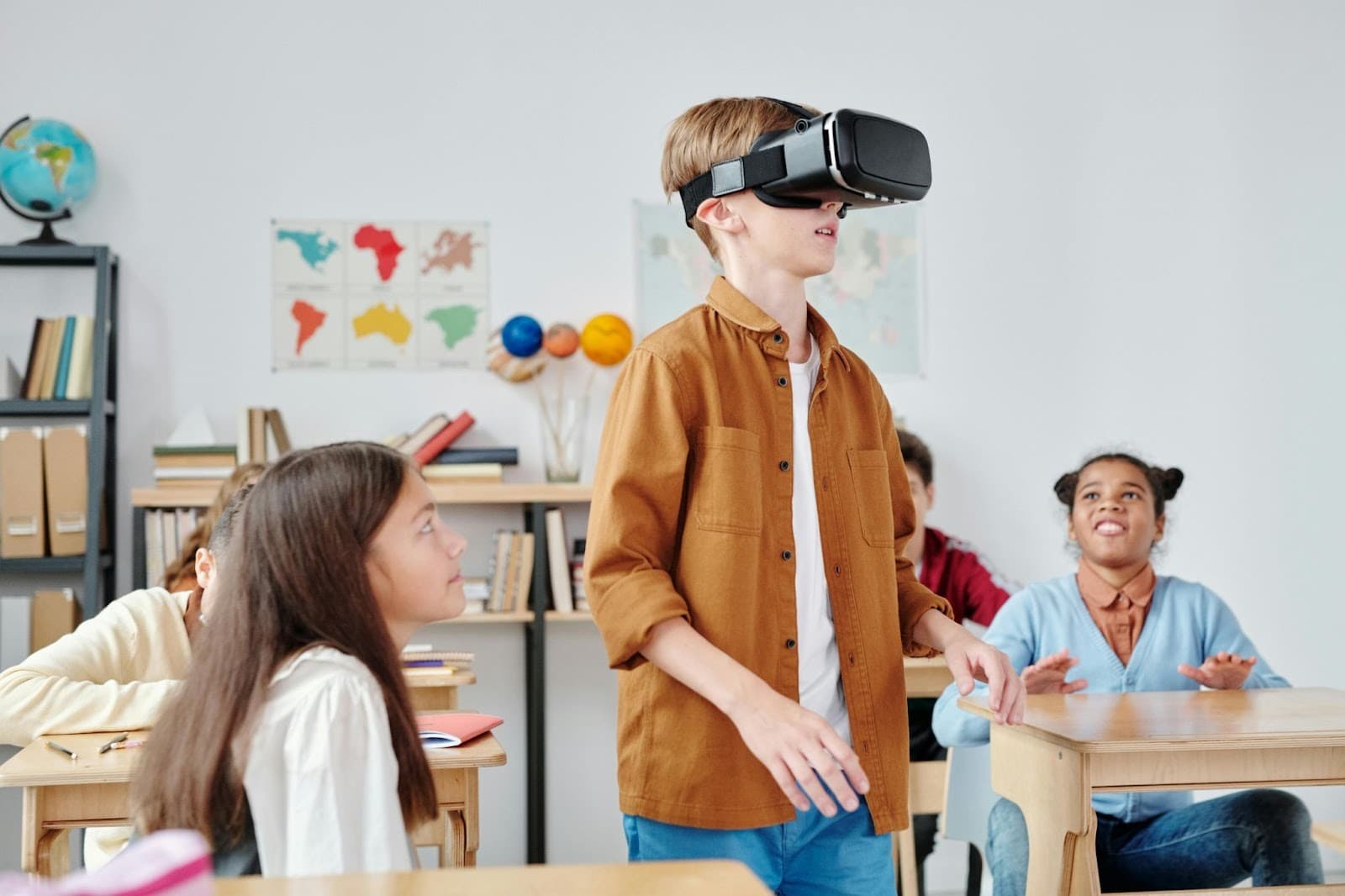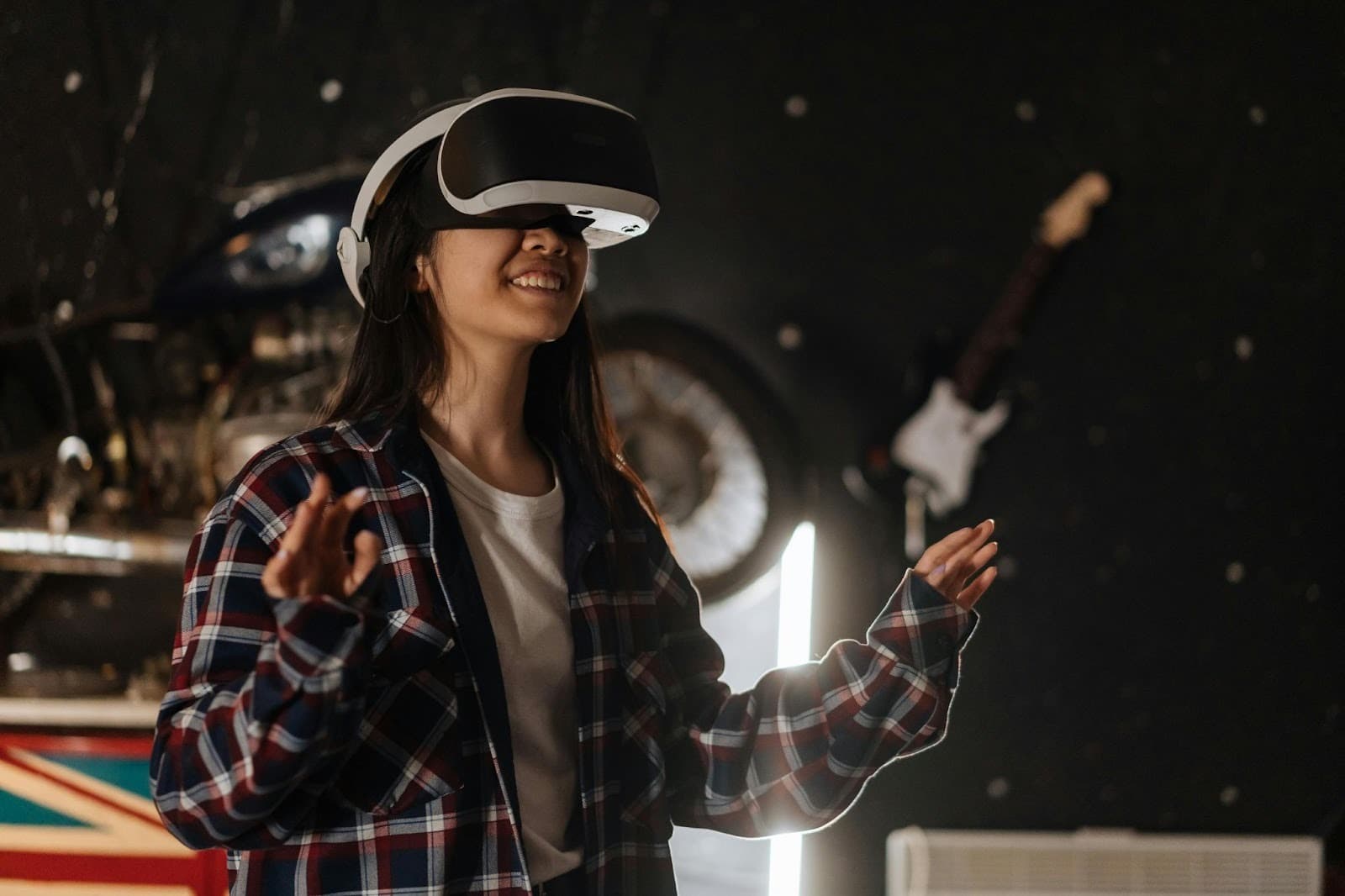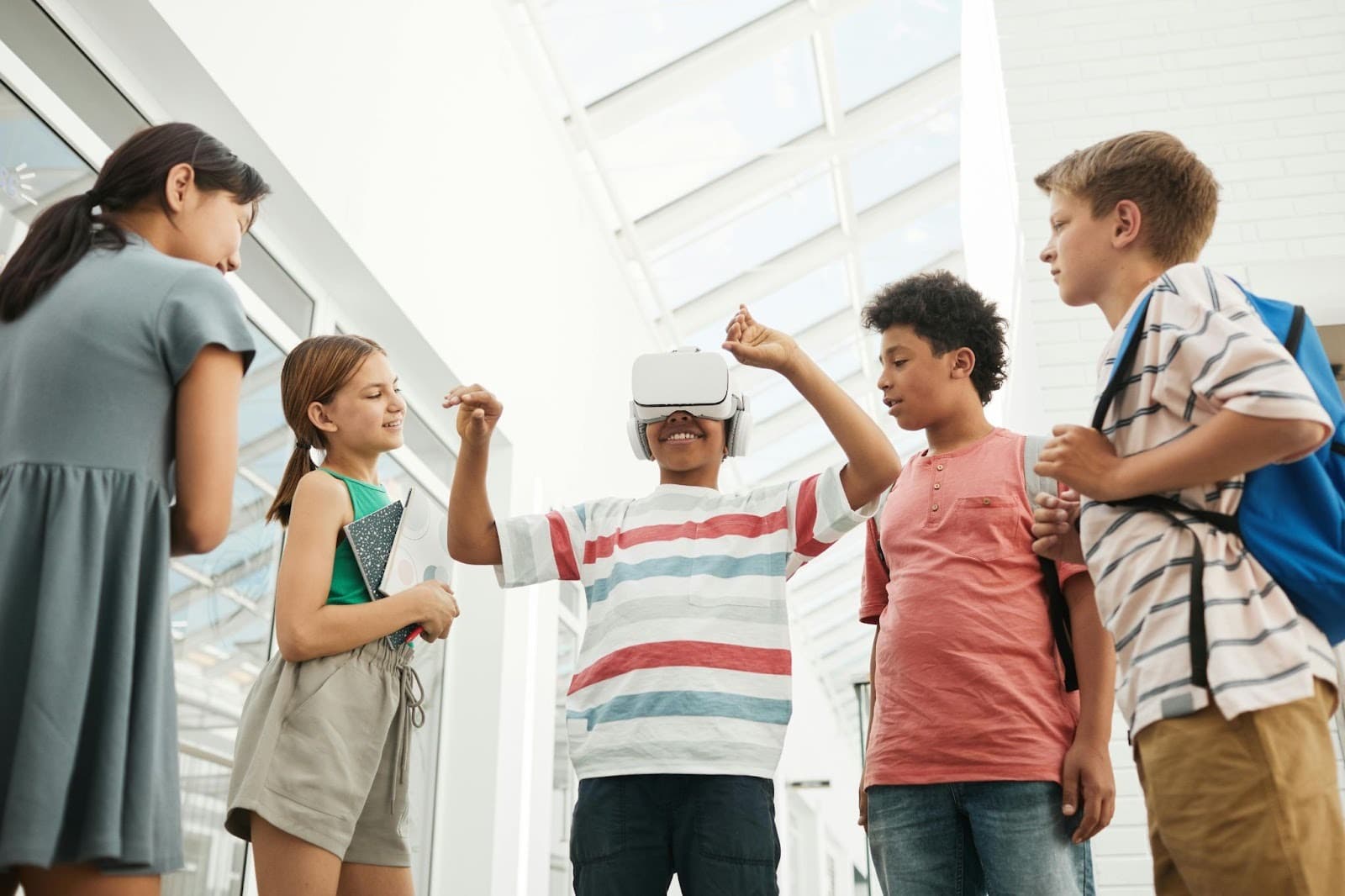Virtual Reality in Education: Impact of VR on Learning & Training in 2026
Virtual Reality (VR) in education is transforming the traditional classroom and ordinary lessons into extraordinary adventures by bringing abstract concepts to life. Through technology, students can float through the solar system, stand on the surface of Mars, or even walk inside a human heart.
VR makes learning fun, interactive, and deeply immersive. It enables students to experience subjects firsthand. VR's hands-on, experiential approach not only boosts knowledge retention but also supports personalized learning, catering to each student's pace and curiosity.
What is Virtual Reality in Education?

Virtual Reality in education uses 3D immersive simulations to create lifelike scenarios where students can learn by doing. It replaces expensive labs, risky experiments, and abstract theories with hands-on experiences that feel real yet are completely safe.
VR applications in education include the following examples:
Medical students “perform” surgeries using VR simulators like Osso VR. The tools respond to their touch, and every incision or movement feels real.
Engineering or aviation students use virtual simulators to operate machinery or fly planes, building real confidence before stepping into the cockpit.
History students can walk through ancient civilizations or stand in the middle of historic events with apps like TimeLooper.
Science learners explore molecules and ecosystems up close using apps like Nanome or Labster; they can watch chemical reactions unfold in 3D.
How Does Virtual Reality in Education Work?

VR works by combining immersive visuals, realistic sound, and motion-tracking technology to place students inside an interactive environment. With headsets and controllers, learners can move, look around, and interact with objects naturally.
Our brains process VR experiences much like real ones. When students perform a virtual surgery or explore a digital jungle, the brain creates a memory as if they’ve actually done it. This is why VR learning feels so real and sticks for longer.
Here's how VR transforms the learning process:
1. Immersive Tools and Hardware
VR headsets, motion sensors, handheld controllers, and VR-ready consoles or PCs create a 360 VR learning space that reacts in real time. If a student reaches out to grab a molecule or turn a valve, the virtual environment reacts, and it triggers real motor learning and spatial awareness in students.
2. Simulation-Based Learning
Students learn by conducting science experiments, performing virtual surgeries with Osso VR, or practicing flight simulations in safe, controlled environments.
3. Collaborative Learning and Global Classrooms
VR connects learners from different parts of the world. It stimulates an ecosystem where international students can meet, interact, and collaborate in shared virtual classrooms.
4. Visualization of Abstract Concepts
Complex topics like molecular biology, physics, or astronomy come alive in 3D. Apps like Titans of Space let students explore the solar system, while 4D Anatomy helps in decoding human biology in depth.
5. Virtual Field Trips
Students can travel anywhere in the world. Immersive tech enables learners to explore the Great Barrier Reef or the inside of a volcano. It turns geography and history lessons into time-traveling adventures.
6. Skill Development and Social-Emotional Learning
VR helps learners develop essential soft skills such as empathy, communication, and teamwork through immersive, role-based scenarios. Companies like Kinful use VR to bring intercultural exchanges to classrooms and enhance social-emotional competencies in kids.
7. Safe and Cost-Effective Training
Virtual environments eliminate risks associated with real-world and workplace training, allowing repeated practice without material costs or safety concerns.
Benefits of Virtual Reality in Education

The following are some of the key benefits of using VR in education:
Enhanced Engagement and Motivation: VR captures students' attention by making lessons interactive and immersive. Learners are more focused and curious when they can explore rather than simply observe.
Improved Knowledge Retention: Studies show that immersive, hands-on experiences improve memory recall. For instance, students learning through VR have demonstrated up to 35% higher retention rates compared to traditional methods.
Experiential Learning: VR lets students learn by doing. Whether performing virtual lab experiments, exploring historical landmarks, or practicing medical procedures, students gain real-world experience without real-world risks.
Improved Understanding of Complex Concepts: Abstract or difficult topics become easier to grasp through 3D visualization. Subjects like anatomy, astronomy, and physics can be explored from multiple angles, deepening comprehension.
Safe and Controlled Learning Environment: VR eliminates physical hazards. Trainees can practice surgery, engineering tasks, or emergency procedures repeatedly without any danger or damage.
Equal Access and Inclusion: Students who can't physically attend classes, go on field trips, or access specific labs can still participate through VR, ensuring inclusive learning opportunities.
Encourages Collaboration and Communication: Multi-user VR platforms allow students from around the world to work together in shared virtual classrooms or projects, fostering teamwork and cultural exchange.
Skill Development and Emotional Intelligence: Through realistic simulations, learners can develop soft skills like empathy, leadership, and problem-solving by navigating real-life scenarios virtually.
Cost-Effective Training at Scale: Although initial setup costs can be high, VR becomes economical over time by reducing material expenses, travel costs, and instructor hours.
How Does Virtual Reality Help Students and Teachers?
There is a growing empirical database that helps prove the positive impact of immersive tech for both students and teachers. Below are key ways VR supports learning, backed by research:
PwC's learning study found VR learners were 4 times faster in completing training and 275% more confident in applying new skills.
A study of 317 high school students found VR-based science lessons improved retention by 35.2%, compared to only 2.6% with traditional teaching.
A 2024 PubMed Central review found that VR boosts student engagement across cognitive, behavioral, and emotional areas. It's especially beneficial for students with learning difficulties. VR also enhances social and emotional learning through immersive role-play and collaboration.
A 2018 University of Maryland study found median recall accuracy rates were significantly higher when information was presented through virtual reality (VR) compared to desktop computers.
Virtual Reality Examples in Education
Astronomy & Space: Apps like Titans of Space let students explore the solar system in 3D, understanding planet sizes, distances, and orbits interactively.
Anatomy & Medicine: 4D Anatomy uses Mixed Reality tech while Osso VR uses VR tech so medical students can examine human organs, perform surgeries, and practice procedures safely.
History & Social Studies: TimeLooper enables virtual field trips to historical sites and cultural landmarks, bringing history to life without leaving the classroom.
Science & Engineering: Platforms like Labster provide virtual laboratories where students conduct experiments and visualize molecules, chemical reactions, or engineering simulations.
Skill Development & Soft Skills: VR role-playing scenarios help learners develop empathy, communication, leadership, and problem-solving abilities in immersive environments. Platforms like Kinful, Transfr, and Project VOISS help students develop essential social skills.
Challenges of Adopting Virtual Reality in Education
High Costs: VR headsets, motion controllers, and software can be expensive, making large-scale adoption difficult for some schools.
Technical Limitations: VR requires compatible hardware, reliable internet, and sufficient space for safe movement.
Teacher Training: Many educators lack experience integrating VR into lessons, which can limit its effectiveness without proper training.
Content Availability: Not all subjects or curricula have high-quality VR applications, limiting where it can be applied.
Motion Sickness & Accessibility: Some students may experience discomfort or have physical limitations that make using VR challenging.
The Future of Virtual Reality in Education
The next wave of VR learning will focus on personalization, AI integration, and global collaboration. Students will learn at their own pace, guided by AI tutors in immersive environments that adapt to their needs.
Personalized Learning: Adaptive VR platforms will cater to each student's pace, learning style, and needs, enhancing understanding and retention.
Hybrid Classrooms: VR will complement traditional teaching, allowing a mix of physical and virtual learning for more flexible education.
Expanded Global Access: Virtual field trips and collaborative VR classrooms will make high-quality learning accessible regardless of location.
AI-Integrated VR: Combining AI with VR could provide real-time guidance, assessments, and tailored feedback, creating highly interactive learning experiences.
Broader Curriculum Applications: As technology becomes cheaper and content grows, VR will likely expand into subjects like arts, social-emotional learning, vocational training, and more.
Immersive Learning with Flam's Mixed Reality Platform
Flam can help universities and institutes stand out with Mixed Reality Ads that bring campuses to life. It transforms ordinary brochures or posters into living, interactive experiences. It can highlight campus facilities, student life, and the institution’s futuristic vision in a way that feels real and memorable. With Flam, organizations can connect with students in a memorable, engaging way.
A powerful example is Jain University's "Summit of Future" campaign, where Flam transformed traditional print communication into an interactive Mixed Reality experience. Students and visitors could scan a QR code on the university's posters and instantly step into a 3D visual world. This creative approach showcases how learning materials can evolve from static to immersive.
Conclusion
Virtual Reality is redefining education by turning lessons into immersive, interactive experiences that students can see, touch, and explore. The power of VR lies in its ability to immerse students in a new environment without stepping outside the physical confines of the classroom. VR technology promises to empower both students and teachers, shaping the classrooms of the future.
If VR can make classrooms more engaging, imagine what it can do for your brand. With Flam, you can turn every ad into an experience that blends the digital and physical worlds. Get in touch with Flam today and step into the future of advertising.
Comments
Your comment has been submitted successfully!